
Loney's Show Notes
By Glenn Loney, November 22, 2006
 |
| Caricature of Glenn Loney by Sam Norkin. |
50th Anniversary
of IATC Celebrated with "Extraordinary Congress" in Seoul: *
Under Discussion & Debate: "New Theatricality & Criticism" *
Colloquia from Several Continents! *
Colloquium #2: Exposés sur l'Europe: *
Colloquium #3: Exposés sur l'Asie: *
Colloquial Afterthoughts: *
Delivering the Message! *
For Bibliophiles: *
First IATC Thalia Prize-winner: ERIC BENTLEY! *
Young Critics Seminars in Seoul: *
Sight-Seeing Around Seoul in Buses with Blue-tinted Windows! *
Sampling the Seoul Performing Arts Festival-- *
With Traditional Korean Shamanism on the Side! *
50th Anniversary of IATC Celebrated with "Extraordinary Congress" in Seoul:
Under Discussion & Debate: "New Theatricality & Criticism"
Unlike San Francisco & Rome, which are putatively built on Seven Hills, South Korea's very modern capital of Seoul seems, instead, to be sprawling over seven mountain-ranges!
This proved something of a challenge for some of the International Theatre Critics who recently checked into the aptly-named Tower Hotel for an Extraordinary Congress, saluting fifty years of Critical Solidarity across national-borders and the seven-seas.
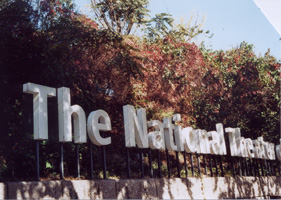 |
| Korea’s
National Theatre has signs in both Korean & English! ©Glenn Loney/INFOTOGRAPHY/2006 |
Most Congress sessions were held at Dongguk University, which is built on a mountain near the Tower Hotel and the Korean National Theatre. As your scribe, one of two Official American Delegates, was suffering from a detached ligament in the right knee--and there were no elevators in the otherwise handsome & modern building containing the Dongguk Art Theatre--the physical challenge was sharp. But the papers and productions on view were an intellectually sharp challenge as well.
This meeting was extraordinary in several ways. It posed a pressing-problem for Theatre Critics from many lands, East & West: The discussion-topic was set as New Theatricality & Criticism. Papers from the Americas, from Europe, and from Asia variously tried to define "Theatricality," though no one seemed to know exactly what the Old Theatricality actually was--or had been.
A clue to this puzzle was revealed in several of the papers, in which basically academic critics--as opposed to those play-reviewers writing for the daily press and a popular audience of readers--noted that traditionally critiques had concentrated on the text, its metaphors, and its larger philosophical, historical, & social implications, rather than how the play actually looked, sounded, & functioned on stage.
Thus, little could be learned--or even discovered--in theatre-critics' essays and Think-pieces from the past about the Theatricality of seminal productions of the past, either in Europe or in the Americas.
This was largely because serious critics--as distinguished from journalist-reviewers--were generally academically trained in literature, rather than in the arts of the theatre. So their critiques often read more like book-reviews than theatre-reviews.
This strange dichotomy is still maintained in a number of American Universities, where plays are taught and studied as texts--not in drama-departments--but in English & Comparative Literature Departments.
Early in the 20th century, the New Stagecraft, as it was then called, was celebrated mainly in the long-defunct Theatre Arts magazine. And often more powerfully in photos of productions by such innovative directors as Max Reinhardt and Edward Gordon Craig, than in the descriptions of avant-garde critics such as Sheldon Cheney.
[Incidental Intelligence: Sheldon Cheney founded Theatre Arts, with Edith J. R. Isaccs as its editor, assisted by the late Rosamond Gilder. And there is a connection with the International Theatre Critics Association, for Ros Gilder was a co-founder of the International Theatre Institute--or ITI--in Paris, under the patronage of UNESCO. She became the International President of ITI, as well as of its American Section, now under TCG, or the Theatre Communications Group.
[Not only did your scribe write for Theatre Arts in its dying years, but he also helped create an ITI-related support-group, AIDART--the Advanced Institute for Development of American Repertory Theatre-- an outgrowth of the 1964 ITI World Congress in New York.
[The co-founders, the late Eldon Elder and the late Bernie Barrow--Ryan, on Ryan's Hope--lost interest after the Congress, leaving your scribe to create a quarterly publication, Today's Theatre, and work in tandem with Ros Gilder in the attic of the ANTA Theatre, formerly the (Theatre) Guild Theatre, and later, the Virginia, and now the August Wilson Theatre.
[As for Theatre Arts--which died because the dishonest publisher had not paid the printer for six months--John Simon wrote the play-reviews, and I did the book-reviews and special features. Simon had to buy his own theatre-tickets, as the publisher kept the press-comps for himself and his mistress. I had to do the book-reviews off the counter at Doubleday's, as he also took the review-copies for himself!]
In any case, several reports at the Seoul Congress--some showing fascinating videos of recent productions--attempted to describe the elements and astonishments of the New Theatricality. The corollary to such expositions was: How do Theatre-Critics respond to challenging innovations? Especially those production & performance hybrids that may not seem to have much in common with conventional Theatre-Experiences?
There were some 90 critics & theatre-scholars on hand to be welcomed by Prof. Yun-Cheol Kim, who had conceived the idea for the Congress and had invited members of IATC last spring in Turin, when IATC had a mini-meeting in the framework of the European Theatre Prize, awarded to Harold Pinter.
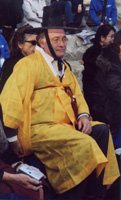 |
| At Shaman performance, IATC President Ian Herbert is clad in traditional Korean garb, including the black horsehair-hat. ©Glenn Loney/INFOTOGRAPHY/2006 |
Ian Herbert, IATC president and founder of The London Theatre Record, followed Dr. Kim's address with a genial response. And there were, of course, other inspiring speeches by Korean dignitaries and critics from near and far.
Seminal was the keynote address of Prof. Bang-Ock Kim, President of the Korean Association of Theatre Critics--and also a professor at Dongguk University. His address--The Critic's Body and the Theatre of ‘Gyee'--asked if critics could be happy: "Can we relax our bodies and minds enough to communicate at a heartfelt level, and to feel we are alive in the theatre?"
This charming talk launched a metaphoric harpoon at the mechanistic heart of Deconstructionist Criticism.
Gyee, it seems, is the Korean word for Chi--which some identify as the unseen Life-Energy Flows which surge unseen through every human body.
In essence, Dr. Kim invited his fellow-critics to sit back and enjoy the Living Theatre--and communicate that to their readers. Rather than destroy the experience with Analytical Semiotics, seeking meaning in Signs & Symbols, instead of in the Play-in-Performance!
Prof. Patrice Pavis, of the University of Paris, suggested that critics might pay more attention to the actual mise-en-scène of a production, rather than concentrating on dramatic-theory and play-texts. He did note that this can be a problem for newspaper-reviewers who have limited space, but the importance of how the production actually looked & played needs to be described.
In this regard, my colleague at Western European Stages, Roy Kift, had this to say recently: "I have dwelt on the simple virtues of staging, for they do at least form the necessary basis for good theatre…" [Italics added, of course!]
This may well have needed saying, considering how many of the delegates were both Academics & Critics--some of whom are still devoted to Semiotics. But this is not such a problem for the majority of American critics for popular publications, who know very well that neither their readers nor their editors are remotely interested in the theories of Derrida. Rather, they want to know: How was the play & should I buy tickets?
Unfortunately, those theatre-critics whose training has been largely theoretical, textual, and analytical are at a disadvantage in dealing with directorial-decisions, as well as the technical and design aspects of a stage-production.
Those who want to prepare for careers as critics of the Performing Arts might do well to study directing, acting, dance-movement, and stagecraft. If, indeed, there are any critic-careers looming in the future…
Colloquia from Several Continents!
The international papers were divided into three Colloquia. Prof. Don Rubin, of Toronto's York University, chaired Colloquium 1, which featured papers from the Americas. [Some forty years ago, Don Rubin was briefly a student of your reporter's, at Hofstra College, as it then was…]
Halima Tahan, of Argentina, discussed the need for Creating the Interlocutory Space: the New Theatricality needs a New Criticism to maintain "the interlocution with the creators of contemporary theatre." As examples of the New Theatricality, she cited the work of Colombia's Mapa teatro and Brazil's Teatro da Vertigem.
Argentina's Periferico de Objectos and the productions of Emilio Garca Wehbi were saluted. According to Tahan: "These ‘works,' fundamentally auto-reflexive and interdisciplinary, present complicated scenic configurations and, in the interpretational aspect, appeal to the principle of ‘polyhedral composition.'"
Well, that really says it all… Or does it suggest that academically-oriented critics are really writing for each other, rather than for the theatre-going public?
[This also suggests that American critics such as Ben Brantley & Terry Teachout would have to stretch their word-counts to deal with such challenges. When La Rajatabla de Caracas presented Bolivar in New York some years ago, it was something of a bafflement to those critics who turned up at LaMaMa ETC. Fortunately, your scribe had already seen it at its world-premiere in Maracaibo, Venezuela, in the company of LaMaMa herself, Ellen Stewart!]
Michel Vaïs--who is also the Secretary-General of IATC--discussed new theatrical forms in Canada, especially in the Province of Quebec, where he edits Jeu, in Montreal. His paper was titled: Description or Judgment?
Actually, even the daily-newspaper reviewer--as well as the academic journal-critic--needs to do both: Describe and Judge. But Michel Vaïs points out that the newer Hybrid forms of performance require some "insightful definitions."
Even now, some theatre-critics avoid dance-theatre and opera performances, preferring to deal with dramatic-texts and performance-traditions with which they are familiar. Hybrids of dance & drama, media-arts, and performance-art can pose even more difficult critical problems.
Nonetheless, at least in Canada, as Vaïs notes, the critic must rise to the challenge, as government-funding of the arts depends on their acknowledgement of these productions in criticism!
Vaïs says: "The difficulty, for the critics who address these new practices, is to avoid superficiality or mere impressionism. Or to be content with a clinical description of the show… But if one specializes, or keeps safely with what one is used to, the risk is to become out of touch with the new practices…"
Carola Oyarzún, of Chile, discussed the "old-fashioned" criticism in Santiago and elsewhere. Usually, the text is regarded as the central element of the performance, so a review is often little different from book-review. Production-values and innovative theatre-practices are seldom noted.
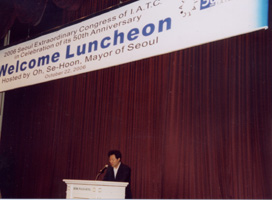 |
| Seoul’s young Mayor, Se-Hoon Oh, welcomes IATC delegates at an elegant luncheon. ©Glenn Loney/INFOTOGRAPHY/2006 |
My American colleague, Kerri Allen, offered a masterful overview of the innovative developments in American theatre--and the reactive developments in criticism and the writing of reviews. She rightly observed that American Theatre is wedded to both the text and to the spectacular. And that it is unique among the world's theatre-cultures.
IATC President Ian Herbert--later summing up all the contributions--saluted Kerri Allen's presentation as one of the most concise and inclusive. But then she was surveying a rich century of theatre-life, with new talents always in the wings, waiting for the opportunity to try Something Entirely Different…
This lively exchange of ideas was followed by an elegant luncheon hosted by His Honor, Se-Hoon Oh, the handsome young Mayor of Seoul. His lovely wife is not only an actress, a director, and a theatre-professor, but she is also a Theatre-Critic!
Colloquium #2: Exposés sur l'Europe:
Ian Herbert moderated the second set of paper-givers, all from Europa. The first think-piece was presented by Prof. Kalina Stefanova, critic & theatre-professor in Sofia, Bulgaria. She is also author or editor of some ten books, one of them on New York Theatre-Critics! [Your scribe was Kalina's mentor when she was a Fulbright Scholar at New York University, so he is very partial to her comments. She is also Vice-President of IATC!]
Dr. Stefanova asks: Could Theatre be "Post-Dramatic"?
Her deliberately provocative paper posited needs for changes in critics' attitudes, receptivities, and even their critical-vocabularies, to keep pace with dramatic innovations. She suggested that "the rapport between Theatre and Criticism--as the rapport between Theatre and its Audience--is an everlasting love-affair…"
As a friend who has been to Bulgarian Theatre in Sofia and American Theatre in Manhattan with Kalina Stefanova, I would rather suggest that this relationship is more often Love/Hate. In fairness, that is My Reaction, not hers.
Nonetheless, when we went to see Mrs. Peter Brook--Natasha Parry--in Brook's staging of Sam Beckett's Happy Days, when it visited Sofia, in the original French, she was not Loving it as much as I was…
Paulo Eduardo Carvalho, in discussing contemporary theatre in Portugal, suggested it may be necessary to write and talk about Performing Arts in future, rather than just Theatre. He questioned the use of such a term as Post-Dramatic Theatre, but acknowledged the need for some new definitions and parameters.
Prof. Ludmila Patlanjoglu, a leading Romanian theatre-critic and Head of the Dept. of Theatre-Science in the National University of Drama and Film-Arts in Bucharest, illustrated her contentions about the Faustian-director with videos of some impressive new Romanian theatre-productions.
[DEVELOP:]
[This injunction refers--not to processing my photos of the Congress Proceedings--but rather to offering a more extended summary of Dr. Patlanjoglu's interesting presentation. I had proposed to do this for all the Colloquium Papers. But the prospect so daunted me that I deferred writing this report until all my photos had indeed been developed.
[In fact, I wrote all the other elements of this report, before returning to the injunctions to Develop!
[This was not exactly Writer's-Block, but more like Mid-Term Exams.
[But at this point, I now realize that most of those who actually read Glenn Loney's Show-Notes are not really desperate to discover what academic-critics had to say to each other last month in Seoul, in prepared papers from which they generally read, rather than communicated spontaneously.
[Anyone who is actually interested in the complete contents of the various essays will be able to get them in print as soon as the Proceedings are published! See details later…]
Sweden's Margareta Sörenson, an expert on Dance-Theatre, made the point that the theatre, as the world, is permanently changing. Theatre-performances in Stockholm in 1506, 1806, 1906, and 2006 were all different experiences.
As she noted: "Change is not a moral quality; it is a fact." [I love that formulation!]
[DEVELOP:]
Britain's John Elsom--who is going to produce a Peter Shaffer revival in Bucharest, where it is much cheaper to mount a production, and then bring it to Britain--had some gloomy thoughts about The Way Ahead. That he is creating a Bucharest dinner-theatre, The Open Secret, suggests, however, that he has Not Given Up!
[DEVELOP:]
Colloquium #3: Exposés sur l'Asie:
China's Liu Yanjun discussed the impressive changes in theatre in China, in the wake of the rapid development of a Market-Economy, although still overseen by an inflexible Communist Government.
[DEVELOP:] [Also note Shanghai's new Theatre District in the former French Diplomatic Quarter!]
Prof. Kwok-kan Tam is a theatre-expert & critic from Hong Kong, a former British Crown Colony. The last one, in fact. His topic was: Performing Self: Race & Identity in Two Hong Kong Plays.
[DEVELOP:]
Prof. Durgadas Mukhopadhyay, from India, discussed: Contemporary and Hybrid Theatre in the Era of Globalization--New Theatricality in India.
[DEVELOP:]
Dr. Manabu Noda is both a theatre-critic and a professor at Japan's Meiji University. His interesting topic was The Body Ill at Ease in Japanese Theatre.
[DEVELOP:]
Dr. Young-Joo Choi is both a theatre-critic and a professor at the Republic of Korea's Sungkyunkwan University. She offered a distinctively Korean overview of Korean Modern Theatre. Considering what the Korean Nation has suffered from Outside Oppression, both before and during World War II, Tradition has been used to recover a "sense of National Identity." At the same time, "notions of Reality have been at the core of Korea's exploration into the existential condition."
[DEVELOP:]
Singapore's Felix Tan Thiam Kim is both a lecturer in Broadcast Journalism and a cultural commentator. He discussed: Finding an Identity: "Hybrid Theatre in Singapore.
[DEVELOP:]
Despite the thoughtful examination of the Congress Topic by various participants, we obviously need a more precise--or expansive--definition of the term: New Theatricality. Or, perhaps, that is not as useful a designation as was intended to cover recent transmutations in Theatre-Production.
It has been said that: There is nothing new under the sun. That is not entirely true, of course. When the Theatre of the Absurd made its appearance in the late 1950s and early 1960s, it was hailed as an entirely new Theatre-genre.
In Theatre Arts, Faubion Bowers enthused about its transformative qualities for the conventional theatre. Editing this essay for the magazine, I insisted that his view was essential nonsense: that the Absurd was in fact, nothing new. Aristophanes had done it first!
So the Editor asked me to write a rebuttal--which infuriated Bowers.
For that matter, the astonishments of a modern drama-production that incorporates Dance, Music, Mime, Art, & Design are but contemporary adaptations of Classic Greek Drama in Athens and at Epidaurus.
Western Theatre grew out of danced & sung performances of Heroic Poetry!
And what about Richard Wagner's concept of the Gesamtkunstwerk?
Nonetheless, there certainly is something new about the New Theatricality, in that it can use film, slide-projections, and electronic-technology completely unknown to the Masters of the Theatre a century ago.
Just imagine what the World Premiere of Medea would have been like if Euripides had owned a video-camera!
At all congresses and functions of the International Association of Theatre-Critics, English & French are the official languages. This must have something to do with the creation of UNESCO & ITI in Paris?
This occasionally creates communication-problems--not because there are no simultaneous-translations available--there always are!--but because some participants must deliver their papers in a language that is not native to them.
[Nonetheless, I was very impressed with the English of many of our Korean colleagues! I could never hope to do half as well in Korean…]
Even if you understand both French & English, it can be a strain to hear either of these tongues mangled. What is more, the struggle to enunciate the foreign-words impedes the potential forcefulness--even the passion--of the presenter.
For that matter, reading a paper can be a fairly Alienation-Effectual Procedure. I found myself dozing off during some presentations, for there seemed no life, no vitality, no conviction about the textual-contentions on the part of the presenter.
Instead of passionate, exciting, challenging critiques & manifestos, what audiences hear are Essays Standing on Their Hind-Legs…
Why not speak spontaneously, with outlined-notes as a back-up? That could also prove transformative in the Lecture-Hall as well!
As with previous IATC congresses, the proceedings will eventually be published, including the complete texts of all the papers given. This usually takes a while as the project needs serious funding. Nonetheless, delegates received a very informative publication from their Korean hosts: Sketching in Contemporary Korean Theatre, edited by Hyung-Ki Kim & Seon-Ok Lim.
Early in the 20th century, Western dramas gained the ascendancy in Korea over traditional performance-forms. This collection of essays deals with the results! In fact, Congress-organizer Prof. Yun-Cheol Kim offers his seminal critique in this compendium: The Influence of Western Drama on Contemporary Korean Theatre.
Obviously, theatre-fans, critics, and researchers are not going to find this book on the shelves of their neighborhood Barnes & Noble or Borders bookshops. Instead, log-on to: www.ktheatrecritics.com!
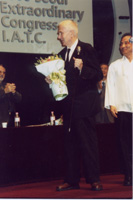 |
| Eric Bentley with flowers and Thalia-Prize walking-stick thanks his International Theatre-Critic friends for the honors! ©Glenn Loney/INFOTOGRAPHY/2006 |
First IATC Thalia Prize-winner: ERIC BENTLEY!
Eric Bentley is now 90 years old, yet he did not need anyone's help to mount the stage at Dongguk University's Art Theatre to receive the first-ever Thalia Prize. Curiously enough, however, the physical symbol of this soon-to-be prestigious-prize is a silver-headed walking-stick!
Topped with the masks of Comedy & Tragedy, the stick was presented by its designer, Dragos Buhagiar, of Bucharest. It unscrews into sections that can be compactly stored in a plush-lined case. [Dragos wanted to know if your scribe was Jewish? He thought my sense of irony was distinctly New York Jewish: Teaching too long at Brooklyn College may have done it…]
I reminded Eric that I had interviewed him thirty years ago, when he was only 60! He thought he looked pretty good then, and he has not changed all that much. His acceptance-address was certainly animated and pointed. But Eric Bentley is only 12 years older than your scribe: I hope I last that long--and look that good at 90!
Despite the initial fame that his journal-reviews had given him, he noted, he'd only written for the New Republic for four years. But this was enough to establish his credentials as an entirely new kind of theatre-critic. He discovered from his journal-experience that what he really needed was the extended-space that writing reviews, essays, and critiques for collection into books made possible.
Certainly his Playwright as Thinker remains a classic of Theatre Criticism, even in a time when very few playwrights show evidence of much Thought. Aside from Tom Stoppard…
When I interviewed Eric three decades ago, I noted that those of my theatre grad-students who had actually taken the trouble to read Playwright as Thinker thought that Eric Bentley must have died quite some time ago. Nonetheless, they were very impressed, not least with his vigorous writing-style. And his early fame lives on, still eclipsing his later plays and his compelling interest in matters of male-sexuality.
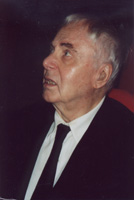 |
| Eric Bentley raptly listens to Prof. Don Rubin’s praises of him and his writings. ©Glenn Loney/INFOTOGRAPHY/2006 |
But there is another compelling reason to honor Eric Bentley: he was the first major critic to introduce and champion the dramas of Bertolt Brecht in the United States. What is perhaps even more important is that he provided eminently playable translations of the Brecht Canon!
Before Bentley's essays and translations, Brecht was virtually unknown on American stages. Actually, he had come to Manhattan in the 1930s to oversee a Labor Stage production of his The Mother, to the eventual annoyance of his Leftist Hosts.
And Brecht's masterpiece, Galileo, had its world-premiere--not in East Berlin, at his Berliner Ensemble stage--but in Los Angeles, where he and his wife, Helene Weigel, sat out their World War II exile from Germany in, of all places, Santa Monica!
Charles Laughton was Brecht's first Galileo, but neither in LA, nor later in New York, did the critics have any understanding of the significance of this seminal work, nor of its distinctive Verfremdungs-Effekt structure.
It remained for Eric Bentley to reveal Brecht's genius and Alienation-Effects to the American Public. And to American Theatre-Critics, as well!
Curious how certain American theatre-critics have become, over time, Ikons, while others have been forgotten. The two Magii remain Eric Bentley and Harold Clurman. John Mason Brown and his colleague, John Gassner--my mentor, have been largely forgotten. Stark Young is named, but not read.
But Clurman's Lies Like Truth and Bentley's Playwright as Thinker remain touchstones. With a nod to Kenneth Tynan and Curtains, of course! [But then Tynan made his reputation in London, only later coming to Manhattan to review for The New Yorker…]
Young Critics Seminars in Seoul:
American Theatre magazine's Randy Gener--initially a NY Theatre-wire reviewer--was one of the Young Critics from various nations chosen to study and evaluate productions on view during the 6th Seoul Performing Arts Festival. They made their collective reports on this adventure in the closing hours of the Extraordinary Congress.
It was apparent that the interactions of critics from different lands and theatre-cultures had been both exciting and instructive. They were fortunate to have been mentored by such veteran-critics as Russia's Nikolai Pesochinsky and Bulgaria's Kalina Stefanova.
Not all of the Young Critics were all that young, and some had certainly been practicing their arts & crafts for some time. Nonetheless, the opportunity to come to Seoul and work with each other, as well as to talk with older, more seasoned critics was well worth the efforts of IATC and its Korean Hosts.
Even while older theatre-critics are finding themselves restricted in word-counts, or eliminated entirely from daily-publication, IATC, the American Theatre Critics Association, and the O'Neill Center continue to develop Young Critics in seminars and summer sessions.
This may seem Self-Defeating: using your Association-Dues to fund seminars to enhance the abilities and opportunities of younger reviewers who will be happy to have your job. If, indeed, there are any print-critic-posts remaining…
What is needed--for both young and old critics--are some seminars on setting up Performing-Arts Critique-Blogs and ArtsNewsWebsites. But there is, of course, no guarantee that anyone will want to read your online Off-Broadway reviews, if the New York Times or the Village Voice will no longer print them.
Performing-Arts gossip is more interesting for blog-scanners than thoughtful analyses of the differing psyches of the characters of Neil La Bute, compared with those of David Mamet.
Sight-Seeing Around Seoul in Buses with Blue-tinted Windows!
One of the major reasons your scribe wanted to come to the Extraordinary Congress--in addition to the collegiality with fellow-critics and the opportunity to sample the productions of Seoul's Performing Arts Festival--was to photograph archival-images of Seoul and the Republic of Korea for his INFOTOGRAPHY™, which now has its own website!
There are now some 300,000 images on file, and they are gradually being digitized to be available online for study and for use in publications & promotions. There are now thousands of images from Hong Kong, Singapore, Taiwan, India, Thailand, Cambodia, Laos, Tibet, Myanmar/Burma, & China, so I wanted to add a portfolio of images from South Korea.
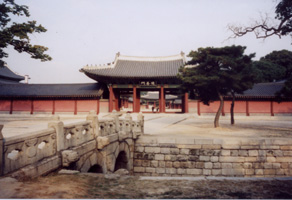 |
| Bridge and formal entrance to Changdeok Palace-complex. ©Glenn Loney/INFOTOGRAPHY/2006 |
But this was not to be: I wrote a letter to the New Jersey office of the Korean Tourist Association, not having any contacts in Seoul. The letter--reproduced below--was not answered, so I called. There was no money available in the budget for such a photo-expedition, alas.
Congress-delegates did get a city sight-seeing bus-trip which ended impressively at the vast Changdeok Palace & Gardens! Somehow, crossing the International Date-Line, I reset my watch incorrectly, so when I turned up at the Tower Hotel lobby for the tour, the bus had already departed!
Fortunately, during the entire Congress, there was a wonderful support-staff of Korean theatre-professor-critics and drama-students on hand to solve all problems. [Prof. Yun-Cheol Kim says there are no less than 40 universities in Seoul alone!]
So I was rapidly dispatched from the hotel in a taxi, whose driver was constantly in touch, via cell-phone, with the staff at the hotel, who were in turn, in contact with the bus-driver's cell-phone.
We missed the group in the teeming market, but triangulated with them outside the Changdeok Palace! Later, on my own, I took the regular Seoul City-Tour. As in Manhattan and Munich, you can jump on and off at specific stations, but--after taking a few iconic-photos--you may have to wait twenty minutes for the next bus.
One dull-looking stop was by an ancient fortress-wall. I didn't get off, but then we rounded a curve to see the Changing of the Palace-Guard in full panoply, with soldiers dressed in brilliant yellow and orange traditional costumes, including those famous stovepipe horsehair hats! This occurred at 1:30 pm, so I have to remember that time for my next trip to Seoul.
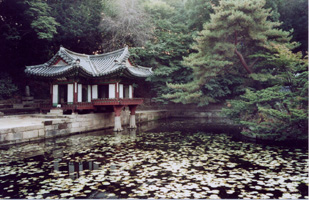 |
| A traditional pavilion and lily-pond in the Changdeok Palace-complex. ©Glenn Loney/INFOTOGRAPHY/2006 |
Seoul is a very large, extensive, handsome, & modern city, with lots of cars, buses, trucks, & vans. After all, Korea is in the forefront of Auto Production! As American once was… And, like Manhattan, it is also a leader in Automotive Gridlock, both by day and in the evening! In some cases, the delegates needed an hour's head-start to reach distant theatres on time.
But then, in the midst of the gridlock, suddenly, with a lurch, the bus leaps forward. And that shot you had lined-up through the window is ruined by a telephone-pole. Blue-tinted bus-windows also do not provide an accurate image of what is actually outside. And there's no time to stop in traffic, get out, and take a photo…
[Similarly, the week following, in Japan, when I was looking for Autumnal Color, the blue-tinted glass made everything look primal green. Some leaves were just beginning to turn, but Global Warming has delayed the Fall Color from late October to mid-November. And the absence of sharp frosts has deterred the emergence of brilliant reds…]
So I must return to Seoul to photograph this intriguing city in some detail. With no blue-tints! As well as to see more of its countryside and other urban-centers!
Actually, one doesn't have to depend on buses, as there is also a State-of-the-art Subway & Train-System. But the schematic plan of these systems looks so complicated that one might have to spend a day or two figuring it out. [That's also the case in Tokyo!]
And here's the letter I wrote to Korean Tourism in Fort Lee:
Thank you for your very prompt response to the materials sent to you by my travel-agents, Mercator. Despite all the email addresses above, I don't do e-mail but let my colleagues take care of messages.
I'd rather spend my remaining months & years taking photos all over the world, than waste time sending & answering e-mails. So I would love to record for posterity some of the Cities & Sites in Korea--beyond Seoul and the IATC Congress. I have enclosed a copy of the letter Prof. Yun-Cheol Kim sent me regarding his expectations of my cameras in Seoul--as he was delighted with the work I did in Turin when Harold Pinter won the 10th European Theatre Prize.
There is also an Official INFOTOGRAPHY Bio, to give you some idea of what I have been doing as a photographer for the past 50 years. I have also enclosed some recent photos made on various photo-expeditions, for your interest.
As the INFOTOGRAPHY website is still "in progress," these photos are not online yet. There are, after all, some 300,000 images to scan and edit, and we have just begun.
Herr Victor Homola, my best friend in Berlin--from which I've just returned--is Office Manager for the New York Times Bureau. And he has just set-up a new website to show off my recent photos and link to websites where my interviews, reports, critiques, and essays are to be found: www.GlennLoney.com
Somewhere on the NYTheatre-Wire.com website--of which I am the Principal Correspondent--my photo-essay on a tour of South Africa & Victoria Falls is archived. For Korea, however, I'd rather offer more photos and less text. Also, I would not expect to be mugged in Korea--as I was on the main-street of Cape Town at High Noon…
I have also enclosed a few pages of various Theatre & Museum reports from those websites for your interest. The Seoul Congress will highlight Korean Performing Arts, so you can imagine Prof. Kim's interest in having me photograph some of the Proceedings & Productions.
The Congress will run from 21-26 October. If it is possible to arrange a press-trip for me for a few days--or even a week--it would be best if it could precede the Congress.
I realize this request is coming to you Out of Left-field…
If it is not possible to arrange this--using Korean Cameras & Films!--Japanese friends in Kyoto & Osaka have invited me to come to photograph Ancient Shrines & Autumn Colors. But--as I will already be in Seoul, it seems more sensible to concentrate on Korea. Especially as I have never visited this Historic Nation!
GLENN LONEY, Prof. of Theatre/CUNY; Cont. Ed: Western European Stages, etc.
Sampling the Seoul Performing Arts Festival--
With Traditional Korean Shamanism on the Side!
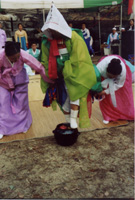 |
| A
Korean Shaman gingerly mounts a kettle of apples. ©Glenn Loney/INFOTOGRAPHY/2006 |
Before arriving in Seoul, your scribe thought he and his critic-colleagues would be seeing an interesting selection of Native Korean Traditional Performance-forms and some new Korean dramas. It never occurred to him that the prosperous Korean economy and the Koreans' eager interest in all forms of the arts would have generated an annual theatre-festival to rival any in Europe!
Perhaps the Edinburgh Fringe Festival is easier to reach, but the offerings this past October in Seoul certainly could match those on view last August in Edinburgh.
Here are some of the International productions played in Seoul: from Hungary, a bitterly ironic Seagull; from Romania, Alexandru Dabija's Three Sisters; from Slovenia, Heiner Müller's Quartet; from Israel, Plonter; from Russia, Andrey Moguchy's Between Dog and Wolf; from China, The Peach Blossom Fan; from France, Maria Donata D'Urso's Collection Particuliére; from England, Heart ‘n Soul Unplugged; from Belgium, Nicole Mossoux's Light!; from Japan, Le Malentendu; from Poland, Krzystof Warlikowski's staging of Sarah Kane's savage Cleansed. [Korea's Jung Hee Park offered her own take on Sarah Kane, with 4.48 Psychosis!]
In addition to a number of interesting Korean stagings, there were also co-productions with Korean & Indian, Korean & German, and Korean & French talents.
The Young Critics actually saw more of the festival productions than their putative seniors. Thus we missed the Korean Mother Courage and Her Children, as well as the Sarah Kane Psychosis--which had already made your scribe psychotic in a French staging at BAM.
What we did see included Plonter, SamulNori, A Beautiful Soulmate, Fairy in the Closet, Kyoung-Suk, Her Father, Between Dog and Wolf, and a venerable Waiting for Godot--a Seoul Hit for 45 years!
From the Cameri Theatre of Tel Aviv, Plonter is a compelling production that would be interesting to see at BAM in Brooklyn. But, as it seriously questions some of the hawkish & punitive policies of the Israeli Government, its potential importation could be prevented by the same Zionist Neo-Cons who intimidated James Nicola, preventing the production of My Name is Rachel Corrie at the New York Theatre Workshop.
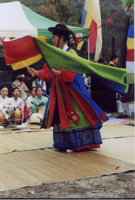 |
| Waving colored flags that symbolize Good Luck, Prosperity, Good Health, and other fortunes, a Korean Shaman performs a ritual dance. ©Glenn Loney/INFOTOGRAPHY/2006 |
Plonter--which is an ancient Hebrew word for knots that cannot be untangled--was created by five Jewish Israeli actors and four Palestinian Arab/Israeli actors in seven months of collaboration, with heated debates from Tel Aviv audiences. A series of tragic events involving both Jews and Arabs are enacted, with no sides taken. Lives are being destroyed, both among the Arabs and the Jews.
Director Ronan Yael and his ensemble have created a powerful vision of Inter-racial Humanity & Inhumanity for which there seems no rational or emotional solution. Unlike the Bush White House, there are some Israelis who do not believe that Immense Fences are the Answer…
Incidentally, the Cameri brought along handsome booklets illustrating the 2005-2006 season in Tel Aviv. How about Hamlet, ‘night, Mother, Badenheim 1939, Eyewitness, Master of the House, High Noon, Oil Town, Antigone, The Producers, or The Rat Laughs? Or Neil LaBute's Fat Pig?
It is surely folklore that Russian Aristocrats used to throw serf-babies out of their regal sleighs to placate the howling wolves racing in their tracks. There is no mention of this practice in Tom Stoppard's Coast of Utopia, now at the Vivian Beaumont Theatre in Lincoln Center.
Nor does it relate in any way to Between Dog and Wolf, staged by Andrey Moguchy for the Formalny Theatre of Russia. This is the second part of Sasha Sokolov's trilogy, of the same name. But the production is less about poetic-texts than it is about dazzling multi-media stage-effects.
Production-photos will visually explain more than mere words. The program-summary, for instance, offers these Gnomic Insights: "Between Dog and Wolf, hope and darkness, poverty and wealth, the past and the future, heaven and earth…"
"The state of avoidance, the inexplicable, a frail sense of being, a yearning for everlasting life…"
"Russia's peculiar ‘beings in between' enter the stage, bringing with them the long tradition of Russian thinking and Pushkin's Eugene Onegin. On each side of a river lives a group of ‘strange people,' and ‘in between' there lives a person called Maria, Marina, or Eternal Love, who invites Death."
Very Russian indeed! And surely eventually to be seen in Brooklyn at BAM?
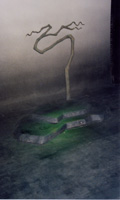 |
| Convoluted Beckettian Tree for Waiting for Godot in Seoul. ©Glenn Loney/INFOTOGRAPHY/2006 |
As for Samuel Beckett's Waiting for Godot--which has been a Seoul Hit for some 45 years--it could also be said that it is not only very Existentially French/Irish, but also very Korean. The Koreans have been waiting for Godot for a very long time!
Young Woong Lim's time-honored production for his Sanwoollim Theatre--with periodic replacements for Didi & Gogo and Lucky & Pozzo--is still fresh and challenging. This production has also been widely toured internationally! And it has a charmingly convoluted leafless silver tree…
Cynical readers may laugh, but Fairy in the Closet is a bittersweet musical monodrama that might well have a success on an American tour of theatres for younger audiences. It would be an interesting choice for Manhattan's New Victory Theatre, in fact.
The charming and very versatile actress, Kim Sung Nyo, plays some 30 characters in this sad tale of a Korean Activist who has to hide in a concealed wall-space in his own home to avoid arrest and certain execution by the South Korean authorities.
His little daughter is at first astonished at the mysterious sounds coming from the wall. Her fearful mother tells her it is a loving-ghost or friendly-fairy. Only in time does she learn the truth, but the years between become emotionally very rich for her.
A Korean fellow-critic--an amusing woman and a theatre-professor--laughingly scolded me for admiring this production so much. But I was touched--not only because we in the West know or understand so little about the forces which divided Korea into two nations--but also by the ingenuity of the solo-actress's performance.
"It's too Sentimental," my new friend explained. But that's OK with me, and I think both American kids and adults will also be touched, especially if Kim Sung Nyo can perform it in English. Many Koreans seem adept in American English, in fact!
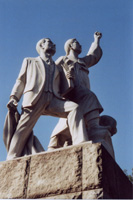 |
| Modern
Koreans--embodied in white-marble--celebrate their freedom from Japanese
Occupation & Atrocities. ©Glenn Loney/INFOTOGRAPHY/2006 |
A different kind of vision of Korean History, in terms of one family, is offered by Kyoung-Sook and Her Father, by Kun-hyoung Park. The baffled young heroine has to live through the Japanese Imperialist Occupation of Korea. This aspect of Japan's "Greater East-Asian Co-Prosperity Sphere" is again something few Americans know about.
But she and her mother have to flee South when American & Soviet Forces clash over the fate of Korea, essentially dividing it into two separate and very unequal halves. Their desperate lives are complicated by her feckless & foolish father, who abandons them, in search of his Impossible Dreams.
This is hardly as wispy & dreamy as Tennessee Williams' Glass Menagerie, however, for Kyoung-Sook and her mother have to make some rather unpleasant choices and compromises in order to survive.
The drama needs some work structurally, but it could provide interesting insights for audiences abroad into these painful periods in Korean history and how they affected individuals and families.
Both in the West and in Europe even Intellectuals--let alone theatre-audiences--know very little about Korea's Agonies in the 20th century. Not to mention familiarity with Koreas' Ancient & Illustrious history!
That was served up in a most melodious and mysterious manner in the Street Theatre Troupe's Three Beautiful Soulmates, which uses traditional costumes, music, ritual, and dance to tell the story of three Buddhist Monks, who follow quite different paths in life in the Goryeo Military Era, with savage outside attacks from Mongolia.
This was a haunting experience that carried its message over into the present!
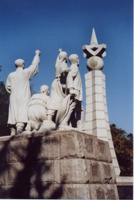 |
| Modern Koreans--frozen in stone--salute their National Symbol. ©Glenn Loney/INFOTOGRAPHY/2006 |
In an even more traditional vein, there was a special performance for the Congress by the Hanullim Performing Troupe of SamulNori, originally centered on four virtuoso drummers, but now enlarged to a company of some thirty dancers and musicians. The troupe has toured widely internationally, including Lincoln Center, UC/Berkeley, and the Kennedy Center in DC. They have won an Obie--as well as praise from the NY Times' Anna Kisselgoff!
The climax of all these performances was a traditional Shaman Ritual on Kangwha Island--which seemed not far from the DMZ!
[Yes, there are still US troops stationed there, left-overs from the "Korean Police-Action," that President Harry S. Truman could not bring to a satisfactory conclusion. In fact, your scribe has the Korean Medal, but he never left Fort Ord when he was in the US Army, so seeing Seoul was a First!]
The Shaman presentation was a colorful and incantory experience, with the critic-audience seated on stone-slabs set into a steep concave mountain-side, with the performance-arena on a level space in front, behind which was another steep incline down to the main road.
It is easier to let some of my INFOTOGRAPHY pix visually describe some moments of this magical event. Less mystical, however, was the ritual cladding of IATC President Ian Herbert in the bright yellow robes and horse-hair hat of Korean Tradition.
A friendly fellow-critic from the Asian sub-continent told me: "It's like the Shaman ceremonies in Nepal! I can even understand some of the language!"
And then there was the ritual stabbing of that splayed pig-carcass that had lain sprawled-out at the side of the arena for most of the afternoon!
Quite a change from Navajo Rain-Dances! Or Irish Step-dancing, for that matter!
Other lands: other customs, other traditions…
Copyright Glenn Loney, 2006. No re-publication or broadcast use without proper credit of authorship. Suggested credit line: "Glenn Loney, New York Theatre Wire." Reproduction rights please contact: jslaff@nytheatre-wire.com.
| museums | NYTW mail | recordings | coupons | classified |